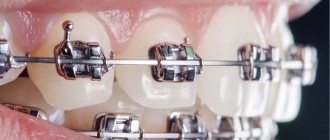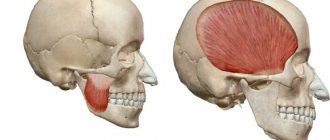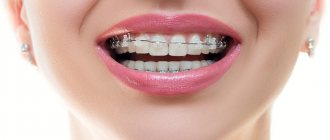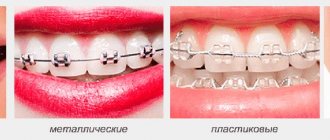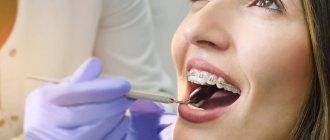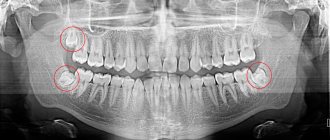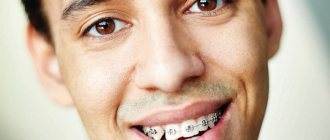Bite problems in children | Self-ligating and ligature systems | Types of self-ligating structures | Material for making braces | Cost of treatment
Parents often ask which braces are best for a teenager, what is the time frame and cost of correcting the bite. The answer to these questions depends on the age of the child and the results of a comprehensive examination: identifying individual characteristics of the development and growth of the facial skeleton, the presence of erupted teeth and tooth germs. During the primary occlusion period, braces are not installed. Orthodontic appliances begin to be worn at the age of 8-9 years: from the moment the upper and lower permanent incisors erupt. For young patients, braces are not fixed on all teeth, but only on four erupted incisors and two permanent molars.
The material was verified by Anna Rimkevich, senior product manager at Ormco Russia.
For children from the age of 12, from the moment of eruption of permanent teeth, the structure is installed on all teeth, just like in adult patients. The latter have no age restrictions on orthodontic treatment. The decision of which braces to place on a patient in adulthood depends on the complexity of the clinical case, the characteristics of the profession, aesthetic requirements and budget.
In the period from 12 to 18 years, the development of the dental system is most active. At this age, adolescents are strongly recommended to be monitored by an orthodontist. If it is necessary to correct the bite, treatment will proceed faster than in adults: bone tissue grows, teeth move easier, the forces of the young body are aimed at growth and formation of the facial skeleton. Early correction of a child’s bite allows one to avoid more complex and expensive treatment in adulthood.
teens with Damon Clear braces
Until what age does a person’s jaw grow? The formation of the jaws and facial bones ends by the age of 25. Until this age, the retention period, stabilization of treatment results, will be twice as long as the period of wearing the braces. Thus, when treated with ligature structures (from 2 to 3.5 years), the retention period will be 4 to 7 years. When correcting the bite using devices without ligatures (from 1 to 2.5 years), the retainer is fixed for 2 to 5 years. Patients over 25 years of age wear a retainer indefinitely.
girl with Damon Q
Prerequisites for bite problems in children
A visit to an orthodontist is a mandatory stage of medical examination for children and adolescents. The growth of the dental system is determined by various parameters: hereditary factors, environmental features of the region, bad habits of the child and psychological disorders.
Bad habits in children cause abnormalities in the growth and development of the facial skeleton and teeth. Prolonged thumb or pacifier sucking and insertion of the tongue between the teeth creates an open bite. Sleeping with your hand under your cheek causes misalignment of the jaw and teeth and causes the development of a crossbite. The infantile type of swallowing forms a distal bite. In such situations, it makes sense for parents to contact a child psychologist. An orthodontist corrects dental anomalies, but does not treat neurological and psychological disorders. After completing the psychological preparation of the child, parents and the doctor will have to choose a bite correction system.
What's happening
After braces are activated, pressure is applied to the crown parts of the teeth located above the gums. But the first changes concern the periodontal ligaments - structures that firmly connect the root and jaw bone. Due to the impact on these ligaments, a person experiences a feeling of pressure, bloating, aching in the jaw, etc. Periodontal attachment is very reliable; it ensures the constancy of the location of each element of the dentition. This area is innervated by nerve endings that respond to pressure, so the first sign that changes have begun to occur is discomfort.
On average, after two to six months, the clinical picture begins to change so much that it becomes noticeable when looking in the mirror or from the side. Cases where the first results are visible within a few weeks are rather the exception to the rule.
Which bracket system is better: self-ligating and ligature designs
Bite correction systems differ in the method of fixing the archwire in the bracket groove. The classic option is ligature constructions. The arch is tightly fixed to each bracket with elastic or metal ligatures. The design is suitable for the treatment of anomalies of varying complexity. It is necessary to visit a doctor once a month to replace the archwires.
Orthos ligature braces
Self-ligating structures do not have elastic and wire elements fixing the arch in the bracket groove. Friction in the system is minimal. Arc sliding occurs under the influence of weak forces. Non-ligation structures do not require monthly visits to the doctor: it is enough to carry out activation once every 2-3 months.
self-ligating Damon Q2
According to the results of research by Khalid S. Hassan from the University of Ed-Dammam, Saudi Arabia, it was revealed that the microbial flora in the oral cavity when using self-ligating systems was lower than when treated with ligature structures. 22 patients participated in the study. In each case, two ligation systems were fixed in the oral cavity: ligature structures were installed on one side, and devices without ligatures were installed on the other. The use of ligature systems caused microbial colonization and increased the activity of the enzyme aspartate aminotransferase. Treatment with self-ligating braces turned out to be a more preferable method of occlusion correction from the point of view of preventing disorders in periodontal tissues.
What are the best braces for a child? Each clinical case requires an individual approach from the orthodontist. Only a doctor, based on the diagnosis and structural features of the young patient’s dental system, offers the most suitable options. As a rule, the issue of aesthetic preferences in children is not as acute as in adults. Teenagers often choose ligature or non-ligature metal systems. A wide variety of elastic ligatures allows you to express the individuality or mood of the child, and the visibility of the design has ceased to be a criterion for choosing a system. Teenagers wear devices with multi-colored elastic elements and do not experience discomfort.
non-ligature Damon 3MX metal
When treating children with braces, it is important for parents to pay attention to teaching the child oral hygiene and motivate them to follow all the orthodontist’s recommendations. Some teenagers, despite the instructions of their parents, pay insufficient attention to hygiene procedures. In this case, installing a non-ligature brace system for a child will be a more preferable option.
The structure of the dentofacial system
In order to understand the mechanics of changing the position of teeth, you need to start with the structure of the dentofacial system. The roots of the teeth are located in sockets in the bone tissue in the alveolar processes of the upper and lower jaw. Between the root of the tooth and the bone there is a ligamentous apparatus of the tooth - connective fibers that fix the tooth in the bone tissue. When braces move teeth, it's not just the crown part we see that moves. The roots of the teeth, under the influence of braces, stretch the ligaments, and the bone tissue under pressure slowly decreases on one side and grows naturally on the other. With the help of braces, the tooth moves gradually and safely through the bone tissue - still securely held by the ligaments.
Active and passive self-ligation
Self-ligation can be passive or active. With the active type of fixation, the bracket clip applies pressure and moves the archwire towards the base of the slot. The orthodontic arch, in turn, puts pressure on the clip. In the case of passive self-ligation, the cover fixes the archwire in the slot without exerting pressure on it. When closed, the bracket turns into a buccal tube: the static cover becomes the fourth wall of the groove, the arch moves freely and is not subject to force. Example: Damon Q.
Damon Q with orthodontic arch
Which braces are best for adults and pediatric patients? American orthodontist Vourdouris JC compared the frictional force of the arch in the bracket groove when using passive and active non-ligature structures. According to a study published in the American J. of Orthodontics & Dentofacial orthopedics, active systems operate with a high friction force of 31.0 g, while passive designs have a low friction force of 0.1 to 0.18 g.
The data obtained scientifically prove that passive self-ligating systems are able to interact with archwires throughout treatment without loss of force and provide a new standard of low friction when moving teeth. American scientists Thorstenson GA and Kusy supplemented the results of the study. Experts have found that when using the Damon System passive self-ligating system, there is significantly lower frictional resistance in dry and wet environments compared to active structures.
Studies conducted by orthodontists indicate the benefits of treatment with passive self-ligating braces.
If not noticeable
Sometimes it seems to the patient that the system is installed, time passes, but no changes are observed. You should ask your doctor questions like these without hesitation. The fact is that understanding the processes that occur with a person and complete trust in the specialist supervising the treatment are key points that ensure the success of the course. Sometimes the first results are not noticeable during a routine examination. This happens, for example, if at the first stage of bite restoration they struggle with retention. Then the results can only be assessed during an examination in the dentist’s chair or with the help of x-rays, which are performed on the direction of a specialist.
Sometimes it happens that the first results really do not appear for a long time. The specialist will definitely see this and take action. These can range from stronger archwire positioning to a complete overhaul of the treatment plan using different techniques. The latter option occurs very rarely, in approximately 1-1.5% of cases. However this happens, all conclusions are provided and deciphered to the patient, and decisions are made mutually based on the facts and options voiced by the orthodontist.
Vestibular and lingual apparatus
Orthodontists install braces in the oral cavity in two ways: on the vestibular (visible) and lingual (in contact with the tongue) side of the dentition. With the lingual type of fixation, aesthetic indicators are higher, but the period of adaptation to internal braces is more difficult. Patients with lingual devices do not experience psychological discomfort: the devices are almost invisible to others. The cost of invisible structures is higher compared to traditional vestibular systems.
lingual braces STb
Oral care rules
- cleaning
. All orthodontic devices serve as a platform for the accumulation of bacterial plaque, so hygiene after correction should be carried out more carefully. It is necessary to select a brush and paste suitable for a specific design, regularly use floss, rinse aids, and an irrigator that effectively washes away bacteria/food particles from hard-to-reach segments with a stream of medication/water; - nutrition
. You should avoid eating sticky/hard foods: candy, chewing gum, chips, crackers, nuts, seeds, dried meat, products with a high sugar content - sweets can cause tooth decay. Tough food increases the risk of structural failure, after which it will need to be replaced. Recommended products: kefir, sour cream, fermented baked milk, pureed soups, mashed potatoes, jelly.
Curvature of the rows and front teeth is a problem not only of aesthetics, but of the health of the body as a whole. There is no need to be afraid of orthodontic treatment - there will be no pain.
Orthodontists at Dr. Razumenko's dental clinic in Moscow know how to help you correct malocclusions, the position of individual units of absolutely any complexity, at any age.
Material of manufacture
In terms of material, there are braces made of metal, ceramic, plastic and combined models. The peculiarities of the manufacturing material, the complexity of the clinical case, aesthetic requirements and financial capabilities allow the doctor and the patient to jointly decide which bracket system is better. There are no universal recommendations.
Ligature systems are made from a metal alloy (Orthos, Mini Diamond) and transparent artificially grown sapphire (aesthetic Inspire ICE). Aesthetic ligature braces are superior in size to metal structures. The disadvantage is more complex activation and an increased period of patient adaptation to foreign structures.
aesthetic sapphire Inspire ICE
Non-ligature structures are made of metal (Damon Q, Damon 3MX) and especially durable ceramics (Damon Clear 2). The adaptation period is easier than when installing devices with ligatures. Treatment with Damon systems is reduced by an average of 7 months compared to treatment with ligature braces.
teens with Damon Q braces
If psychological comfort or the characteristics of an adult patient’s profession require an inconspicuous system, it is advisable to choose Inspire ICE sapphire braces or Damon Clear 2 ceramic braces. For a child, sapphire and ceramic structures are not always a good choice due to increased fragility: a teenager can accidentally damage the elements of the system as a result injury or poor diet.
transparent Inspire ICE on typodont
Start of treatment
There is a lot of information on the Internet on forums that the first results are detected within a couple of weeks, and sometimes even a few days after installing the system in the oral cavity. There cannot be significant changes within a few hours after installing braces; self-hypnosis works here.
An experienced dentist, before starting treatment, always warns the patient that there are no exact dates regarding the advancement of teeth. There are only indicative data, but they may differ greatly from the real picture.
When installing a braces system, in most cases, the doctor uses a medium-section arch, which has a gentle effect on the teeth. This is necessary in order to gently initiate the beginning of the advancement or revolution of the teeth around their axis. Theoretically, this process can be accelerated by using a thick, rigid arc that will press on the enamel with great force, but this approach will make the adaptation period too uncomfortable and painful. In addition, this can lead to disruption of regeneration and nutritional processes in deep tissues, which do not have time to adapt to rapid changes and significant displacements of tooth roots. To avoid such serious complications, the specialist starts the process slowly. A gradual and slow start is a prerequisite for the success of the further course.
Prices for teeth straightening
To estimate the cost of teeth straightening for adults, schedule a consultation with our dentistry office. To do this, fill out an application on the website or call.
| Code no. | Name of procedures | Unit of measurement | Cost, rub. |
| 313 | Artistic restoration (front, side teeth) simple | 1 unit | 11 000,00 |
| 314 | Artistic restoration (changes in shape and position) complex | 1 unit | 13 000,00 |
| 730 | Tooth treatment for ceramic composite restorations | 9 500,00 | |
| 808 | Veneer – Vener | 19 000,00 | |
| 811 | Application of metal-free ceramics on a dioxide frame | 29 000,00 |
* The prices indicated on the website are not a public offer. The exact cost of treatment can only be determined at an appointment with a doctor.
Prices for treatment in Moscow full price list
Share on social media networks:
Article Expert:
Oganesyan Diana Feliksovna
Dentist-orthodontist. He regularly improves his professional level and studies modern methods of orthodontic treatment at international seminars and conferences of outstanding orthodontists in the world. He is a member of the Italian Society of Orthodontists (SIDO) and the European Aligner Association (EAS).
Work experience over 6 years
How to choose effective dental braces for your child?
The choice of braces depends on the age of the patient. The optimal period for bite correction is considered to be adolescence. At the age of 12-14 years, the teeth are completely replaced by permanent ones, but at the same time the high elasticity of bone tissue and its ability to regenerate are preserved. Therefore, treatment of bite in adolescents occurs most quickly and effectively.
However, during puberty, children are very concerned about their appearance, which is why many categorically refuse to wear noticeable metal braces or insist on lingual braces, which will be invisible to others. The doctor’s task is to choose a correction option that will achieve the desired result while maintaining self-esteem.
Lingual braces are not recommended for children, as they can have a negative impact on diction and lead to incorrect pronunciation in the future. Therefore, the orthodontist often suggests that teenagers install ceramic or sapphire braces, as they are the most aesthetically pleasing and have the least impact on diction.
Metal braces are considered the most effective for correcting malocclusion in adults. After 25 years, bone tissue dissolves and grows more slowly, so increased pressure on the teeth is required. Metal braces can provide this. Ceramic and sapphire models are suitable for correcting mild or moderate disorders. They will also ensure the aesthetics of your smile.
The duration of wearing the braces system depends on the patient’s age, the material of the braces, design features and other factors. The specific period is determined by the orthodontist after a complete diagnosis, but on average you need to be prepared to wear the braces for 2-3 years.
Wearing braces: average time, minimum, maximum
Children's orthodontists have long collected statistics on how long it takes from fixation to removal of braces:
- quick treatment – six months to a year;
- the average for severe anomalies is 1-2.5 years;
- the maximum period (registered record) is more than 9 years.
Every year the complexity and duration of treatment increases. Correcting the same pathology at 27 years old will require almost a year more time than at 18 years old.
